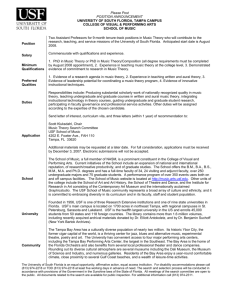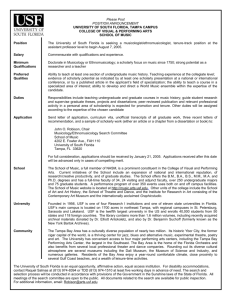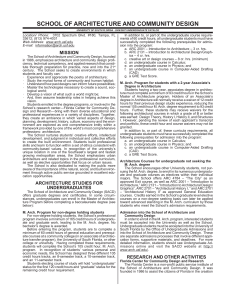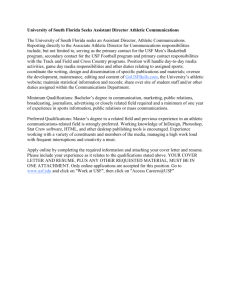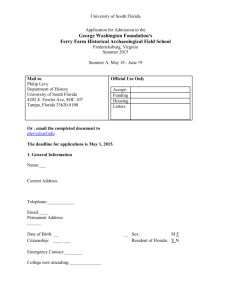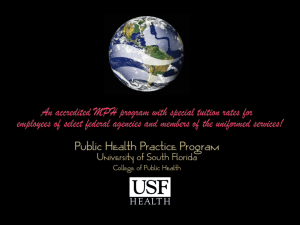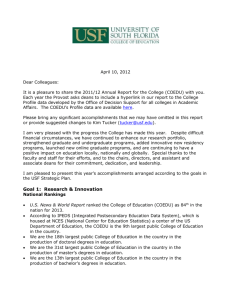school of architecture and community design
advertisement
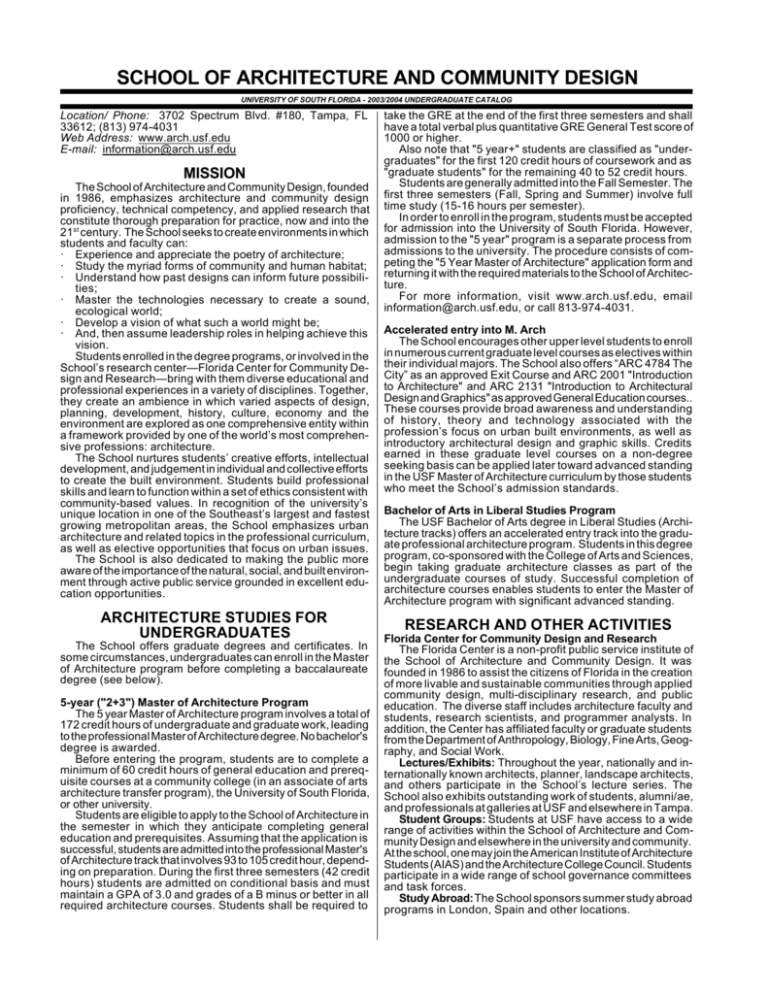
SCHOOL OF ARCHITECTURE AND COMMUNITY DESIGN UNIVERSITY OF SOUTH FLORIDA - 2003/2004 UNDERGRADUATE CATALOG Location/ Phone: 3702 Spectrum Blvd. #180, Tampa, FL 33612; (813) 974-4031 Web Address: www.arch.usf.edu E-mail: information@arch.usf.edu MISSION The School of Architecture and Community Design, founded in 1986, emphasizes architecture and community design proficiency, technical competency, and applied research that constitute thorough preparation for practice, now and into the 21st century. The School seeks to create environments in which students and faculty can: · Experience and appreciate the poetry of architecture; · Study the myriad forms of community and human habitat; · Understand how past designs can inform future possibilities; · Master the technologies necessary to create a sound, ecological world; · Develop a vision of what such a world might be; · And, then assume leadership roles in helping achieve this vision. Students enrolled in the degree programs, or involved in the School’s research center—Florida Center for Community Design and Research—bring with them diverse educational and professional experiences in a variety of disciplines. Together, they create an ambience in which varied aspects of design, planning, development, history, culture, economy and the environment are explored as one comprehensive entity within a framework provided by one of the world’s most comprehensive professions: architecture. The School nurtures students’ creative efforts, intellectual development, and judgement in individual and collective efforts to create the built environment. Students build professional skills and learn to function within a set of ethics consistent with community-based values. In recognition of the university’s unique location in one of the Southeast’s largest and fastest growing metropolitan areas, the School emphasizes urban architecture and related topics in the professional curriculum, as well as elective opportunities that focus on urban issues. The School is also dedicated to making the public more aware of the importance of the natural, social, and built environment through active public service grounded in excellent education opportunities. ARCHITECTURE STUDIES FOR UNDERGRADUATES The School offers graduate degrees and certificates. In some circumstances, undergraduates can enroll in the Master of Architecture program before completing a baccalaureate degree (see below). 5-year ("2+3") Master of Architecture Program The 5 year Master of Architecture program involves a total of 172 credit hours of undergraduate and graduate work, leading to the professional Master of Architecture degree. No bachelor's degree is awarded. Before entering the program, students are to complete a minimum of 60 credit hours of general education and prerequisite courses at a community college (in an associate of arts architecture transfer program), the University of South Florida, or other university. Students are eligible to apply to the School of Architecture in the semester in which they anticipate completing general education and prerequisites. Assuming that the application is successful, students are admitted into the professional Master's of Architecture track that involves 93 to 105 credit hour, depending on preparation. During the first three semesters (42 credit hours) students are admitted on conditional basis and must maintain a GPA of 3.0 and grades of a B minus or better in all required architecture courses. Students shall be required to take the GRE at the end of the first three semesters and shall have a total verbal plus quantitative GRE General Test score of 1000 or higher. Also note that "5 year+" students are classified as "undergraduates" for the first 120 credit hours of coursework and as "graduate students" for the remaining 40 to 52 credit hours. Students are generally admitted into the Fall Semester. The first three semesters (Fall, Spring and Summer) involve full time study (15-16 hours per semester). In order to enroll in the program, students must be accepted for admission into the University of South Florida. However, admission to the "5 year" program is a separate process from admissions to the university. The procedure consists of competing the "5 Year Master of Architecture" application form and returning it with the required materials to the School of Architecture. For more information, visit www.arch.usf.edu, email information@arch.usf.edu, or call 813-974-4031. Accelerated entry into M. Arch The School encourages other upper level students to enroll in numerous current graduate level courses as electives within their individual majors. The School also offers “ARC 4784 The City” as an approved Exit Course and ARC 2001 "Introduction to Architecture" and ARC 2131 "Introduction to Architectural Design and Graphics" as approved General Education courses.. These courses provide broad awareness and understanding of history, theory and technology associated with the profession’s focus on urban built environments, as well as introductory architectural design and graphic skills. Credits earned in these graduate level courses on a non-degree seeking basis can be applied later toward advanced standing in the USF Master of Architecture curriculum by those students who meet the School’s admission standards. Bachelor of Arts in Liberal Studies Program The USF Bachelor of Arts degree in Liberal Studies (Architecture tracks) offers an accelerated entry track into the graduate professional architecture program. Students in this degree program, co-sponsored with the College of Arts and Sciences, begin taking graduate architecture classes as part of the undergraduate courses of study. Successful completion of architecture courses enables students to enter the Master of Architecture program with significant advanced standing. RESEARCH AND OTHER ACTIVITIES Florida Center for Community Design and Research The Florida Center is a non-profit public service institute of the School of Architecture and Community Design. It was founded in 1986 to assist the citizens of Florida in the creation of more livable and sustainable communities through applied community design, multi-disciplinary research, and public education. The diverse staff includes architecture faculty and students, research scientists, and programmer analysts. In addition, the Center has affiliated faculty or graduate students from the Department of Anthropology, Biology, Fine Arts, Geography, and Social Work. Lectures/Exhibits: Throughout the year, nationally and internationally known architects, planner, landscape architects, and others participate in the School’s lecture series. The School also exhibits outstanding work of students, alumni/ae, and professionals at galleries at USF and elsewhere in Tampa. Student Groups: Students at USF have access to a wide range of activities within the School of Architecture and Community Design and elsewhere in the university and community. At the school, one may join the American Institute of Architecture Students (AIAS) and the Architecture College Council. Students participate in a wide range of school governance committees and task forces. Study Abroad: The School sponsors summer study abroad programs in London, Spain and other locations. SCHOOL OF ARCHITECTURE AND COMMUNITY DESIGN 69 UNIVERSITY OF SOUTH FLORIDA - 2003/2004 UNDERGRADUATE CATALOG Accreditation and Licensure: Applicants for architectural licensure in Florida, and most jurisdictions in the United States, normally must have: · earned a professional degree from a School accredited by the National Architectural Accrediting Board (NAAB) · completed the Intern Development Program (IDP) · passed the Architect Registration Examination (ARE) According to the 1998 edition of the NAAB Conditions and Procedures: “In the United States, most state registration boards require a degree from an accredited professional degree program as a prerequisite for licensure. The National Architectural Accrediting Board (NAAB), which is the sole agency authorized to accredit US professional degree programs in architecture, recognized two types of degrees: The Bachelor of Architecture and the Master of Architecture. A program may be granted a fiveyear, three-year, or two-year term of accreditation, depending on its degree of conformance with established educational standards. Masters degree programs may consist of preprofessional undergraduate degree and a professional graduate degree, which, when earned sequentially, comprise an accredited professional education. However, the pre-professional degree is not, by itself, recognized as an accredited degree.” The Master of Architecture program at USF is fully accredited.
